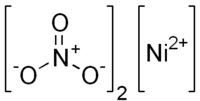Nickel(II) nitrate
| Nickel(II) nitrate | |
|---|---|
 | |
_nitrate.jpg) | |
| IUPAC name Nickel(II) nitrate | |
| Other names Nickel nitrate | |
| Identifiers | |
| CAS number | 13138-45-9 13478-00-7 (hexahydrate) |
| PubChem | 25736 |
| ChemSpider | 23976 |
| EC number | 238-076-4 |
| Jmol-3D images | {{#if:[Ni+2].[O-][N+]([O-])=O.[O-][N+]([O-])=O|Image 1 |
| |
| |
| Properties | |
| Molecular formula | Ni(NO3)2 |
| Molar mass | 182.703 g/mol (anhydrous) 290.79 g/mol (hexahydrate) |
| Appearance | emerald green hygroscopic solid |
| Odor | odorless |
| Density | 2.05 g/cm3 (hexahydrate) |
| Melting point | 56.7 °C (hexahydrate) |
| Boiling point | 136.7 °C (hexahydrate) |
| Solubility in water | 94.2 g/100ml (20 °C) 158 g/100ml (60 °C) |
| Solubility | soluble in ethanol |
| Refractive index (nD) | 1.422 (hexahydrate) |
| Structure | |
| Crystal structure | monoclinic (hexahydrate) |
| Hazards | |
| MSDS | External MSDS |
| EU Index | 028-012-00-1 |
| EU classification | Oxidant (O) Carc. Cat. 1 Muta. Cat. 3 Repr. Cat. 2 Toxic (T) Harmful (Xn) Irritant (Xi) Dangerous for the environment (N) |
| R-phrases | R49, R61, R8, R20/22, R38, R41, R42/43, R48/23, R68, R50/53 |
| S-phrases | S53, S45, S60, S61 |
| NFPA 704 |
 0
2
0
OX
|
| Flash point | Non-flammable |
| LD50 | 1620 mg/kg (oral, rat) |
| Related compounds | |
| Other anions | Nickel(II) sulfate Nickel(II) chloride |
| Other cations | Palladium(II) nitrate |
| Related compounds | Cobalt(II) nitrate Copper(II) nitrate |
| Except where noted otherwise, data are given for materials in their standard state (at 25 °C (77 °F), 100 kPa) | |
| Infobox references | |
Nickel nitrate is the chemical compound Ni(NO3)2 or any hydrate thereof. The anhydrous form is not commonly encountered, thus "nickel nitrate" usually refers to nickel(II) nitrate hexahydrate. The formula for this species is written in two ways. Ni(NO3)2.6H2O and, more descriptively [Ni(H2O)6](NO3)2. The latter formula indicates that the nickel(II) center is surrounded by six water molecules in this hydrated salt. The nitrate anions are not bonded to nickel.
Safety
Like other nitrates, nickel nitrate is oxidizing, so that caution should be exercised when it contacts with reducing materials such as organic substances. It is also irritating to the eyes, skin and, upon inhalation of the dust, respiratory tract. It may cause skin allergy. Nickel nitrate is a carcinogen, along with most other nickel compounds. The nickel ion is also toxic to aquatic organisms.
References
| |||||||||||
| HNO3 | He | |||||||||||||||||
| LiNO3 | Be(NO3)2 | B(NO3)3 | C | N | O | F | Ne | |||||||||||
| NaNO3 | Mg(NO3)2 | Al(NO3)3 | Si | P | S | ClONO2 | Ar | |||||||||||
| KNO3 | Ca(NO3)2 | Sc(NO3)3 | Ti | V | Cr(NO3)3 | Mn(NO3)2 | Fe(NO3)3 | Co(NO3)2, Co(NO3)3 | Ni(NO3)2 | Cu(NO3)2 | Zn(NO3)2 | Ga(NO3)3 | Ge | As | Se | Br | Kr | |
| RbNO3 | Sr(NO3)2 | Y | Zr | Nb | Mo | Tc | Ru | Rh | Pd(NO3)2 | AgNO3 | Cd(NO3)2 | In | Sn | Sb | Te | I | Xe | |
| CsNO3 | Ba(NO3)2 | Hf | Ta | W | Re | Os | Ir | Pt | Au | Hg2(NO3)2, Hg(NO3)2 | Tl(NO3)3 | Pb(NO3)2 | Bi(NO3)3 | Po | At | Rn | ||
| Fr | Ra | Rf | Db | Sg | Bh | Hs | Mt | Ds | Rg | Cn | Uut | Fl | Uup | Lv | Uus | Uuo | ||
| ↓ | ||||||||||||||||||
| La | Ce | Pr | Nd | Pm | Sm | Eu | Gd(NO3)3 | Tb | Dy | Ho | Er | Tm | Yb | Lu | ||||
| Ac | Th | Pa | UO2(NO3)2 | Np | Pu | Am | Cm | Bk | Cf | Es | Fm | Md | No | Lr | ||||